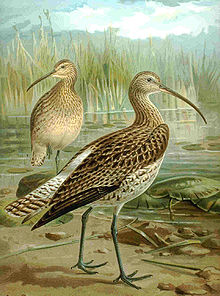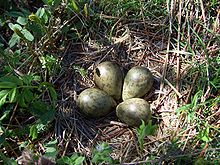Eurasian curlew
| Eurasian Curlew | |
|---|---|

| |
| Scientific classification | |
| Kingdom: | |
| Phylum: | |
| Class: | |
| Order: | |
| Family: | |
| Genus: | |
| Species: | N. arquata
|
| Binomial name | |
| Numenius arquata (Linnaeus, 1758)
| |
The Eurasian Curlew, Numenius arquata, is a wader in the large family Scolopacidae. It is the one of the most widespread of the curlews, breeding across temperate Europe and Asia. There have even been sightings in Nova Scotia. In Europe this species is often referred to just as Curlew, and in Scotland an alternative name is 'whaup'.
This is a migratory species over most of its range, wintering in Africa, southern Europe and south Asia. It is present all year in the milder climate of Ireland, Great Britain and the adjacent European coasts. It is highly gregarious outside the breeding season.
This is the largest wader in its range, at 50-57 cm length, and a 1m wingspan. It is mainly greyish brown, with a white back, and a very long curved bill (longest in the adult female). It is generally wary. The familiar call from which this bird gets it name is a loud curloo-oo.

The only similar species over most of the Curlew's range is the Whimbrel. This is smaller, and has a shorter bill with a kink rather than a smooth curve.
This species feeds by probing soft mud for small invertebrates, but will also pick small crabs and earthworms off the surface if the opportunity arises.
The nest is a bare scrape on taiga, meadow or similar habitat. 3-6 eggs are laid, and incubated for about a month to hatching.
The Eurasian Curlew is one of the species to which the Agreement on the Conservation of African-Eurasian Migratory Waterbirds (AEWA) applies.

References
- Template:IUCN2006 Database entry includes justification for why this species is of least concern
- Birds of Nova Scotia
External links
- Eurasian Curlew videos on the Internet Bird Collection
